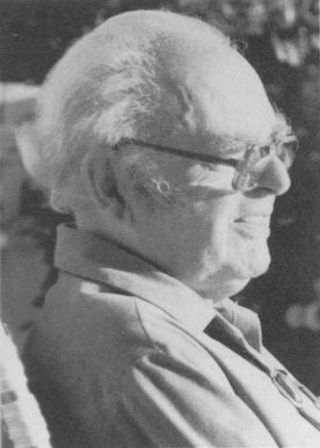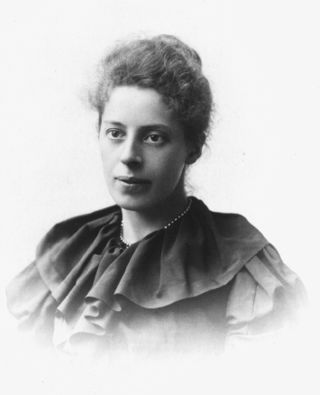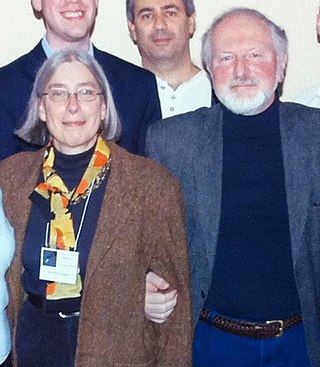
Sandra Moore Faber is an American astrophysicist known for her research on the evolution of galaxies. She is the University Professor of Astronomy and Astrophysics at the University of California, Santa Cruz, and works at the Lick Observatory. She has made discoveries linking the brightness of galaxies to the speed of stars within them and was the co-discoverer of the Faber–Jackson relation. Faber was also instrumental in designing the Keck telescopes in Hawaii.

Helen Battles Sawyer Hogg was an American-Canadian astronomer who pioneered research into globular clusters and variable stars. She was the first female president of several astronomical organizations and a scientist when many universities would not award scientific degrees to women. Her scientific advocacy and journalism included astronomy columns in the Toronto Star and the Journal of the Royal Astronomical Society of Canada. She was considered a "great scientist and a gracious person" over a career of sixty years.

The Astronomical Society of the Pacific (ASP) is an American scientific and educational organization, founded in San Francisco on February 7, 1889, immediately following the solar eclipse of January 1, 1889. Its name derives from its origins on the Pacific Coast, but today it has members all over the country and the world. It has the legal status of a nonprofit organization.

Bartholomeus Jan "Bart" Bok was a Dutch-American astronomer, teacher, and lecturer. He is best known for his work on the structure and evolution of the Milky Way galaxy, and for the discovery of Bok globules, which are small, densely dark clouds of interstellar gas and dust that can be seen silhouetted against brighter backgrounds. Bok suggested that these globules may be in the process of contracting, before forming into stars.

Isaac Roberts FRS was a Welsh engineer and businessman best known for his work as an amateur astronomer, pioneering the field of astrophotography of nebulae. He was a member of the Liverpool Astronomical Society in England and was a fellow of the Royal Geological Society. Roberts was also awarded the Gold Medal of the Royal Astronomical Society in 1895.
Terence Dickinson was a Canadian amateur astronomer and astrophotographer who lived near Yarker, Ontario, Canada. He was the author of 14 astronomy books for both adults and children. He was the founder and former editor of SkyNews magazine. Dickinson had been an astronomy commentator for Discovery Channel Canada and taught at St. Lawrence College. He made appearances at such places as the Ontario Science Centre. In 1994, the International Astronomical Union committee on Minor Planet Nomenclature named asteroid 5272 Dickinson in honour of his "ability to explain the universe in everyday language".
Jay Myron Pasachoff was an American astronomer. Pasachoff was Field Memorial Professor of Astronomy at Williams College and the author of textbooks and tradebooks in astronomy, physics, mathematics, and other sciences.
Deborah Byrd is an American science journalist. She is editor-in-chief of EarthSky, which presents science news and night sky information. The website served more than 21 million users in 2019, according to Google Analytics.
The Hubble Heritage Project was founded in 1998 by Keith Noll, Howard Bond, Forrest Hamilton, Anne Kinney, and Zoltan Levay at the Space Telescope Science Institute. Until its end in 2016, the Hubble Heritage Project released, on an almost monthly basis, pictures of celestial objects like planets, stars, galaxies and galaxy clusters.

Dorothea Klumpke Roberts was an American astronomer. She was the Director of the Bureau of Measurements at the Paris Observatory and was made a Chevalier de la Légion d'Honneur, or a Knight of the National Order of the Legion of Honor.
The Gordon Myers Amateur Achievement Award, known until 2018 as the Amateur Achievement Award of the Astronomical Society of the Pacific, is one of nine annual astronomical awards managed by the Astronomical Society of the Pacific. It recognizes "significant contributions to astronomy or amateur astronomy by those not employed in the field of astronomy in a professional capacity." The contributions can be done in the fields of both observational astronomy or astronomical technologies. The award has been given to amateur astronomers from various countries since 1979 and has become one of the most geographically diverse astronomical awards.
Priscilla Fairfield Bok was an American astronomer and the wife of Dutch-born astronomer Bart Bok, Director of Mount Stromlo Observatory in Australia and later of Steward Observatory in Arizona, US. Their harmonious marriage accompanied the four decades of their close scientific collaboration, in which "it is difficult and pointless to separate his achievements from hers". They co-authored a number of academic papers on star clusters, stellar magnitudes, and the structure of the Milky Way galaxy. The Boks displayed great mutual enthusiasm for explaining astronomy to the public: described as "salesmen of the Milky Way" by The Boston Globe, their general interest book The Milky Way went through five editions and was said to be "one of the most successful astronomical texts ever written".

Andrew Fraknoi is a retired professor of astronomy recognized for his lifetime of work using everyday language to make astronomy more accessible and popular for both students and the general public. In 2017 Fraknoi retired from his position as Chair of the Department of Astronomy at Foothill College. In retirement he continues to teach through the Fromm Institute for Lifelong Learning and the Osher Lifelong Learning Institute at San Francisco State University, to give public lectures, and to add to his body of written work. He is the recipient of numerous awards and honors in his field.

Heidi B. Hammel is a planetary astronomer who has extensively studied Neptune and Uranus. She was part of the team imaging Neptune from Voyager 2 in 1989. She led the team using the Hubble Space Telescope to view Shoemaker-Levy 9's impact with Jupiter in 1994. She has used the Hubble Space Telescope and the Keck Telescope to study Uranus and Neptune, discovering new information about dark spots, planetary storms and Uranus' rings. In 2002, she was selected as an interdisciplinary scientist for the James Webb Space Telescope.

Martha Patricia Haynes is an American astronomer who specializes in radio astronomy and extragalactic astronomy. She is the distinguished professor of arts and sciences in astronomy at Cornell University. She has been on a number of high-level committees within the US and International Astronomical Community, including advisory committee for the Division of Engineering and Physical Sciences of the National Academies (2003–2008) and Astronomy and Astrophysics Decadal Review. She was a vice-president of the executive committee of the International Astronomical Union from 2006–2012, and was on the board of trustees of Associated Universities Inc from 1994 until 2016, serving two terms as board chair and one year as interim president.

The Société astronomique de France, the French astronomical society, is a non-profit association in the public interest organized under French law. Founded by astronomer Camille Flammarion in 1887, its purpose is to promote the development and practice of astronomy.

David Morrison is an American astronomer, a senior scientist at the Solar System Exploration Research Virtual Institute, at NASA Ames Research Center in Mountain View, California. Morrison is the former director of the Carl Sagan Center for Study of Life in the Universe at the SETI Institute and of the NASA Lunar Science Institute. He is the past Director of Space at NASA Ames. Morrison is credited as a founder of the multi-disciplinary field of astrobiology. Morrison is best known for his work in risk assessment of near Earth objects such as asteroids and comets. Asteroid 2410 Morrison was named in his honor. Morrison is also known for his "Ask an Astrobiologist" series on NASA's website where he provides answers to questions submitted by the public. He has published 12 books and over 150 papers primarily on planetary science, astrobiology and near Earth objects.

Sidney Carne Wolff is an American astrophysicist, researcher, public educator, and author. She is the first woman in the United States to head a major observatory, and she provided significant contributions to the construction of six telescopes. Wolff served as Director of the Kitt Peak National Observatory (KPNO) and the National Optical Astronomy Observatory (NOAO). She is a member of the International Astronomical Union's Division G: Stars and Stellar Physics.
Isabel Trecco Hawkins is an Argentine-American astronomer and science educator. Formerly a researcher in the isotopic composition of the interstellar medium and on the cosmic microwave background at the University of California, Berkeley, her interests have shifted to science popularization, as a senior scientist for the Exploratorium in San Francisco.













